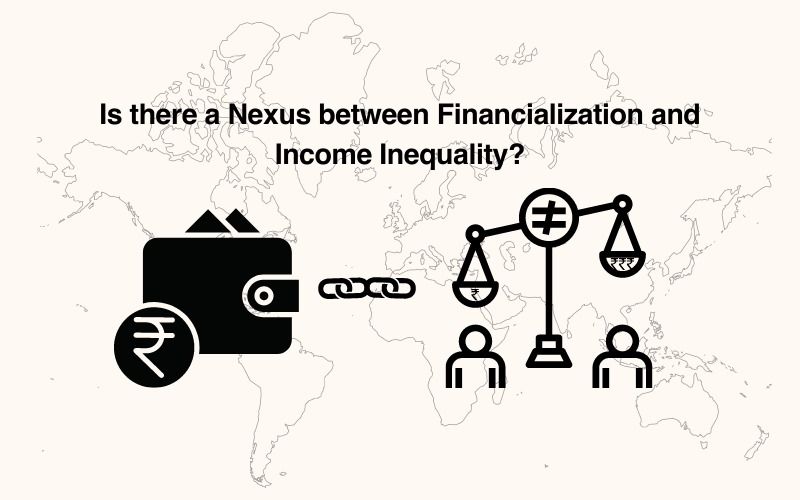Is there a Nexus between Financialization and Income Inequality?

This post has been authored by Manish Vaidya, the Economic Research Intern at Arthashastra Intelligence.
Financialization is a gradual process in which financial markets, financial institutions, financial governing and regulatory bodies, and financial activities have a more significant influence and impact propagating the discourse of the economy and economic policymaking. There is a transformation in functioning at both the macro and micro levels.
In advanced economies, rapid financialization has led to increased fragility, rising household debt-income ratios, rising corporate debt-to-equity ratios, income inequality, productivity disparities, and widening wage inequality.
The link between financialization and income inequality
The link between increasing financialization and inequality can be explained through various channels. One such link is the banking sector. When more money is flooded into the banking system, it gives banks the opportunity to generate excess income and profits. This in some way leads to the monopolization of the banking sector. The flow of income, profits, and rents is streamlined to those who are connected and within this sector, leading to rising income inequality. This, however, is somewhat an infant phenomenon, in essence, observed when a country’s overall financial sector is in its primary stage, and banks are dominating intermediaries. This cannot be said when assessing India. Banks had a mere 34% share in FY 21-22, in the flow of funds in the economy. Fintech and capital markets occupy the larger space.
In Fig 1, the X axis is the Gini Coefficient, which is essentially an index showing the extent of income inequality. It is a measure of dispersion ranging between 1 and 100. 1 indicates perfect equality whereas 100 indicates maximum inequality.
Source: Statista; Compilation and Visualization By Arthashastra Intelligence.
Turning to financial markets, Fig 2, indicates India’s stock market capitalization, clearly showing an upward trend. The tract however is plausibly volatile as compared to Fig 1. It can be said, with an eyeball test that income inequality and rapid financialization, are indeed related, and have casual effects between them. It is essential to note, this phenomenon is not just limited to India.
Source: Statista; Compilation and Visualization By Arthashastra Intelligence.
The existing research literature on studying this nexus, is usually in the context of a “Financial Kuznets Curve(FKC) hypothesis” or “Non-linearity hypothesis”. This curve, is a simple plot with financialization on the X-axis and Income Inequalty on the Y-axis. A typical FKC must exhibit an “inverted U” shape. In simple words, income inequality rises initially uptill a turning point, and then drops steeply. Now, the reasoning behind this shape can be attributed to progressive taxes, government income redistribution efforts, advancement of financial sectors covering all income groups and so on, that lead to the downward tract from the turning point.
It is evident that this does not hold true for India. A report by Oxfam puts forward that Indian billionaires increased their wealth by a staggering 35% during the COVID pandemic, the very periods where an economic slump was in play. These were the times when the wealthiest escaped the wrath of the pandemic and the poor faced unemployment, poverty and worse, death. Studies focus on fitting regression equations. Income inequality, is influenced by a basket of factors, financialization being one of them.
A very relevant and recent study for India found that, financial development, inflation and economic growth too, aggravate income inequality. It is a compelling time to reframe and formulate wealth and capital taxation policies, and better income distribution measures.
India is yet in the initial steps pertaining to financialization. Income concentration or pooling is a visible phenomenon. Better taxation regimes, increasing the spans of alternative finance, and assessing other contributing factors toward inequality are the right steps ahead.
References:
- Kang-Kook Lee & Md Abu Bakkar Siddique (2021) Financialization and income inequality: An empirical analysis, The Japanese Political Economy, 47:2-3, 121-145, DOI: 10.1080/2329194X.2021.1945465
- Palley, Thomas I. 2007. “Financialization: What It Is and Why It Matters.” The Levy Economics Institute 1-31. https://www.levyinstitute.org/pubs/wp_525.pdf.
- Ibrahim N. Khatatbeh & Imad A. Moosa (2022) Financialization and income inequality: An extreme bounds analysis, The Journal of International Trade & Economic Development, 31:5, 692-707, DOI: 10.1080/09638199.2021.2005668
- Ang, James. (2010). Finance and Inequality: The Case of India. Southern Economic Journal. 76. 738-761. 10.4284/sej.2010.76.3.738.
- Ibrahim N. Khatatbeh, Wasfi Al Salamat, Mohammed N. Abu-Alfoul & Jamil J. Jaber | Goodness Aye (Reviewing editor) (2022) Is there any financial Kuznets curve in Jordan? a structural time series analysis, Cogent Economics & Finance, 10:1, DOI: 10.1080/23322039.2022.2061103
- Sehrawat, M. and Giri, A.K. (2015), “Financial development and income inequality in India: an application of ARDL approach”, International Journal of Social Economics, Vol. 42 No. 1, pp. 64-81. https://doi.org/10.1108/IJSE-09-2013-0208
- Retrieved from The Hindu (Author: Jagrti Chandra): Indian billionaires increased their wealth by 35% during the lockdown, says Oxfam repor
